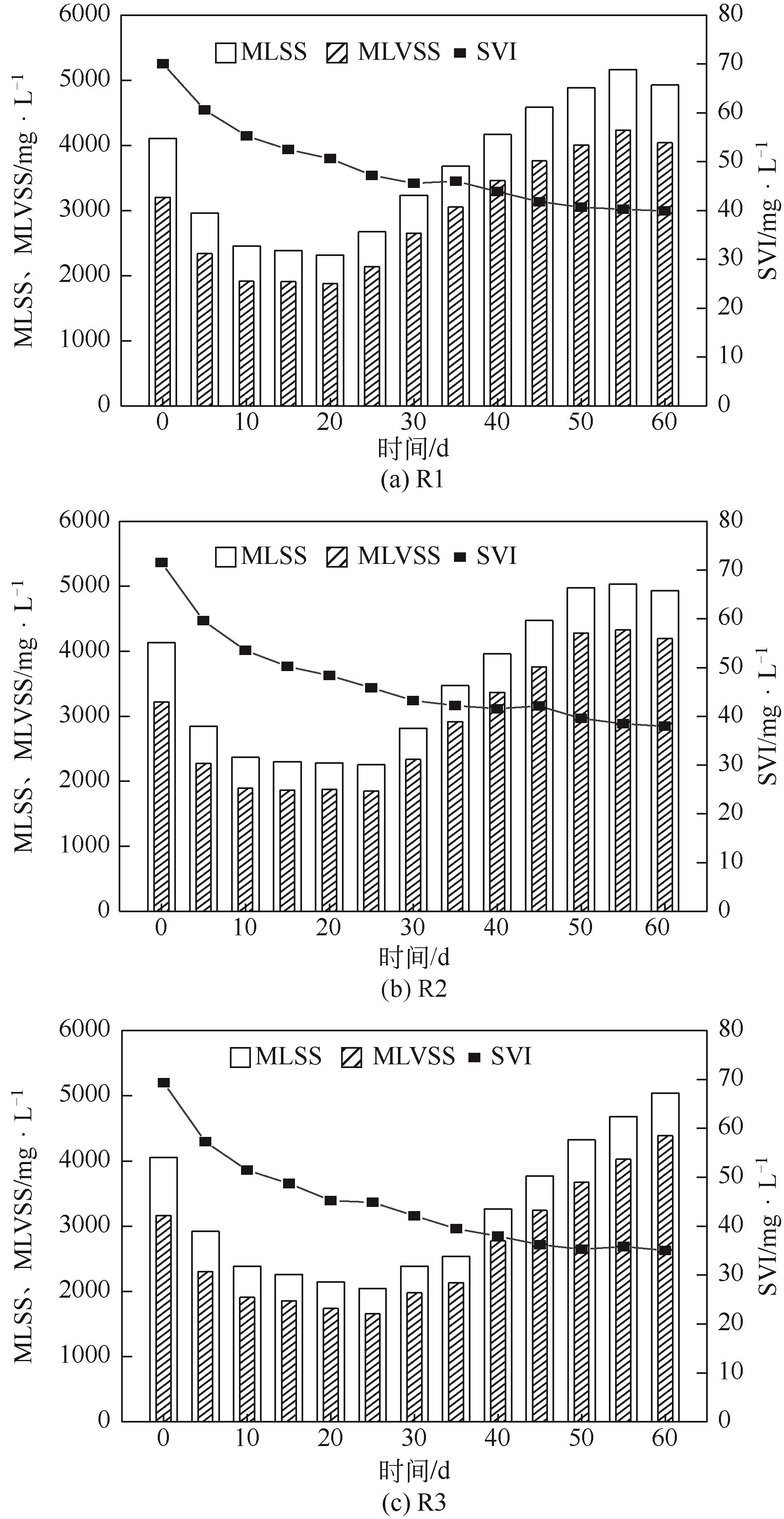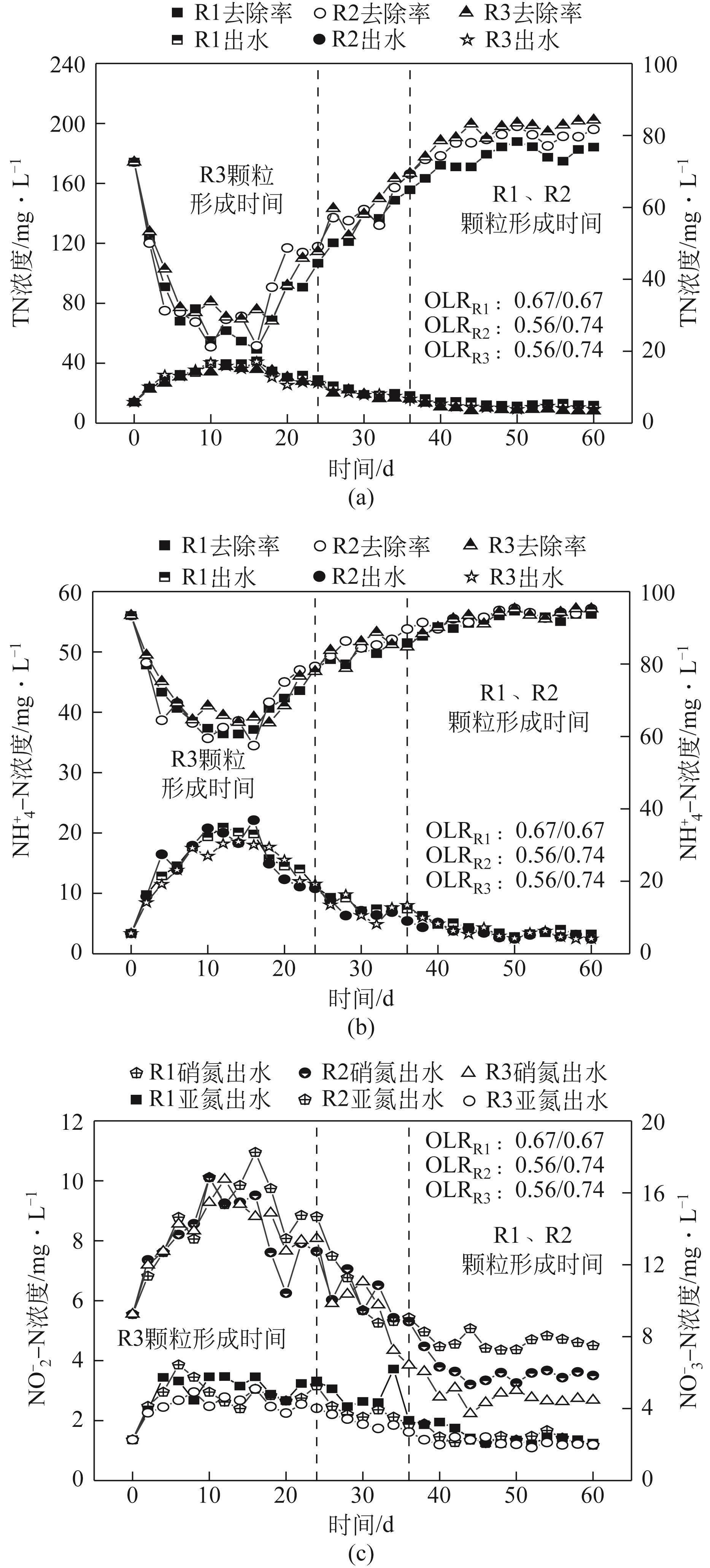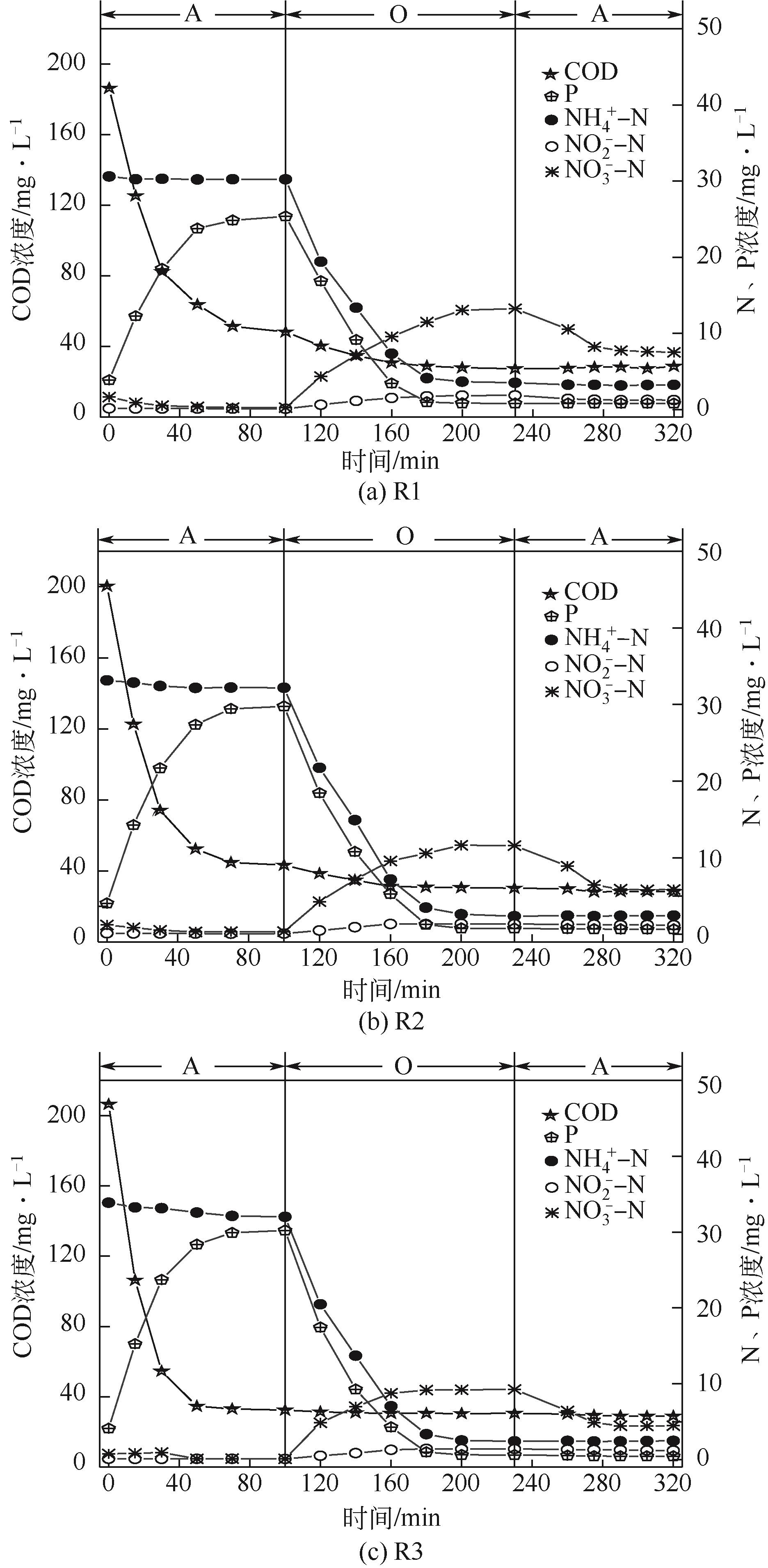Chemical Industry and Engineering Progress ›› 2022, Vol. 41 ›› Issue (12): 6680-6688.DOI: 10.16085/j.issn.1000-6613.2022-0226
• Resources and environmental engineering • Previous Articles Next Articles
Effect of organic load fluctuation frequency on aerobic granular sludge
LI Dong1( ), GAO Feiyan1, XIE Yibo1, LI Zhu1, ZHANG Jie1,2
), GAO Feiyan1, XIE Yibo1, LI Zhu1, ZHANG Jie1,2
- 1.Key Laboratory of Beijing Water Quality Science and Water Environment Recovery Engineering, Beijing University of Technology, Beijing 100124, China
2.State Key Laboratory of Urban Water Resource and Environment, Harbin Institute of Technology, Harbin 150090, Heilongjiang, China
-
Received:2022-02-14Revised:2022-04-14Online:2022-12-29Published:2022-12-20 -
Contact:LI Dong
有机负荷波动频次对好氧颗粒污泥的影响
- 1.北京工业大学水质科学与水环境恢复工程北京市重点实验室,北京 100124
2.哈尔滨工业大学城市水资源与 水环境国家重点实验室,黑龙江 哈尔滨 150090
-
通讯作者:李冬 -
作者简介:李冬(1976—),女,博士生导师,教授,主要研究方向为水环境恢复理论及关键技术。E-mail:lidong2006@bjut.edu.cn。 -
基金资助:北京高校卓越青年科学家计划(BJJWZYJH01201910005019)
CLC Number:
Cite this article
LI Dong, GAO Feiyan, XIE Yibo, LI Zhu, ZHANG Jie. Effect of organic load fluctuation frequency on aerobic granular sludge[J]. Chemical Industry and Engineering Progress, 2022, 41(12): 6680-6688.
李冬, 高飞雁, 解一博, 李柱, 张杰. 有机负荷波动频次对好氧颗粒污泥的影响[J]. 化工进展, 2022, 41(12): 6680-6688.
share this article
Add to citation manager EndNote|Ris|BibTeX
URL: https://hgjz.cip.com.cn/EN/10.16085/j.issn.1000-6613.2022-0226
| 反应器 | 低OLR模式每日进水量/L | 低OLR/gCOD·L-1∙d-1 | 高OLR模式每日进水量/L | 高OLR/gCOD·L-1∙d-1 | OLR波动频次 |
|---|---|---|---|---|---|
| R1 | 10 | 0.67 | 10 | 0.67 | 0 |
| R2 | 7 | 0.56 | 13 | 0.74 | 1 |
| R3 | 7 | 0.56 | 13 | 0.74 | 3 |
| 反应器 | 低OLR模式每日进水量/L | 低OLR/gCOD·L-1∙d-1 | 高OLR模式每日进水量/L | 高OLR/gCOD·L-1∙d-1 | OLR波动频次 |
|---|---|---|---|---|---|
| R1 | 10 | 0.67 | 10 | 0.67 | 0 |
| R2 | 7 | 0.56 | 13 | 0.74 | 1 |
| R3 | 7 | 0.56 | 13 | 0.74 | 3 |
| 项目 | COD /mg·L-1 | NH /mg·L-1 | NO /mg·L-1 | NO /mg·L-1 | PO /mg·L-1 | pH |
|---|---|---|---|---|---|---|
| 数值 | 300±25 | 45~55 | <1 | 0~2 | 6~7 | 7.6~8.0 |
| 项目 | COD /mg·L-1 | NH /mg·L-1 | NO /mg·L-1 | NO /mg·L-1 | PO /mg·L-1 | pH |
|---|---|---|---|---|---|---|
| 数值 | 300±25 | 45~55 | <1 | 0~2 | 6~7 | 7.6~8.0 |
| 反应器 | CODu/mg·L-1 | CODin/% | PRA/mg·L-1 | PPAOs/% | SND率/% |
|---|---|---|---|---|---|
| R1 | 133.97 | 97.06 | 24.56 | 50.60 | 44.74 |
| R2 | 154.61 | 98.37 | 29.00 | 52.27 | 58.20 |
| R3 | 172.04 | 98.91 | 29.61 | 59.86 | 64.62 |
| 反应器 | CODu/mg·L-1 | CODin/% | PRA/mg·L-1 | PPAOs/% | SND率/% |
|---|---|---|---|---|---|
| R1 | 133.97 | 97.06 | 24.56 | 50.60 | 44.74 |
| R2 | 154.61 | 98.37 | 29.00 | 52.27 | 58.20 |
| R3 | 172.04 | 98.91 | 29.61 | 59.86 | 64.62 |
| 1 | LIU Yu, Joohwa TAY. State of the art of biogranulation technology for wastewater treatment[J]. Biotechnology Advances, 2004, 22(7): 533-563. |
| 2 | QIU Bangqiao, LIAO Guohao, WU Chuandong, et al. Rapid granulation of aerobic granular sludge and maintaining its stability by combining the effects of multi-ionic matrix and bio-carrier in a continuous-flow membrane bioreactor[J]. Science of the Total Environment, 2022, 813: 152644. |
| 3 | TAO Jia, QIN Lian, LIU Xiaoying, et al. Effect of granular activated carbon on the aerobic granulation of sludge and its mechanism[J]. Bioresource Technology, 2017, 236: 60-67. |
| 4 | VERAWATY M, PIJUAN M, YUAN Z G, et al. Determining the mechanisms for aerobic granulation from mixed seed of floccular and crushed granules in activated sludge wastewater treatment[J]. Water Research, 2012, 46(3): 761-771. |
| 5 | MOY B Y P, TAY J, TOH S K, et al. High organic loading influences the physical characteristics of aerobic sludge granules[J]. Letters in Applied Microbiology, 2002, 34(6): 407-412. |
| 6 | CHEN Han, LI Ang, CUI Di, et al. Evolution of microbial community and key genera in the formation and stability of aerobic granular sludge under a high organic loading rate[J]. Bioresource Technology Reports, 2019, 7: 100280. |
| 7 | WANG Shuguang, GAI Lihong, ZHAO Lijian, et al. Aerobic granules for low-strength wastewater treatment: formation, structure, and microbial community[J]. Journal of Chemical Technology & Biotechnology, 2009, 84(7): 1015-1020. |
| 8 | LIN Huihua, MA Rui, HU Yaping, et al. Reviewing bottlenecks in aerobic granular sludge technology: slow granulation and low granular stability[J]. Environmental Pollution, 2020, 263: 114638. |
| 9 | YANG Yachun, LIU Xiang, WAN Chunli, et al. Accelerated aerobic granulation using alternating feed loadings: alginate-like exopolysaccharides[J]. Bioresource Technology, 2014, 171: 360-366. |
| 10 | IORHEMEN O T, LIU Y. Effect of feeding strategy and organic loading rate on the formation and stability of aerobic granular sludge[J]. Journal of Water Process Engineering, 2021, 39: 101709. |
| 11 | ZHANG Zhiming, YU Zhoudong, DONG Jingjing, et al. Stability of aerobic granular sludge under condition of low influent C/N ratio: correlation of sludge property and functional microorganism[J]. Bioresource Technology, 2018, 270: 391-399. |
| 12 | FRØLUND B, GRIEBE T, NIELSEN P H. Enzymatic activity in the activated-sludge floc matrix[J]. Applied Microbiology and Biotechnology, 1995, 43(4): 755-761. |
| 13 | LIU Hong, FANG H Hanping. Extraction of extracellular polymeric substances (EPS) of sludges[J]. Journal of Biotechnology, 2002, 95(3): 249-256. |
| 14 | WANG Xiaoxia, WANG Shuying, XUE Tonglai, et al. Treating low carbon/nitrogen (C/N) wastewater in simultaneous nitrification-endogenous denitrification and phosphorous removal (SNDPR) systems by strengthening anaerobic intracellular carbon storage[J]. Water Research, 2015, 77: 191-200. |
| 15 | NIU Wenyu, GUO Jianbo, LIAN Jing, et al. Rapid start-up of denitrifying granular sludge by dosing with semi-starvation fluctuation C/N ratio strategy[J]. Bioresource Technology, 2017, 241: 945-950. |
| 16 | WANG Yayi, WANG Jiaqin, LIU Zhiping, et al. Effect of EPS and its forms of aerobic granular sludge on sludge aggregation performance during granulation process based on XDLVO theory[J]. The Science of the Total Environment, 2021, 795: 148682. |
| 17 | HAAKSMAN V A, MIRGHORAYSHI M, VAN LOOSDRECHT M C M, et al. Impact of aerobic availability of readily biodegradable COD on morphological stability of aerobic granular sludge[J]. Water Research, 2020, 187: 116402. |
| 18 | ZHANG Yihao, DONG Xiaochuan, NURAMKHAAN M, et al. Rapid granulation of aerobic granular sludge: a mini review on operation strategies and comparative analysis[J]. Bioresource Technology Reports, 2019, 7: 100206. |
| 19 | DE KREUK M K, KISHIDA N, VAN LOOSDRECHT M C M. Aerobic granular sludge-state of the art[J]. Water Science and Technology, 2007, 55(8/9): 75-81. |
| 20 | LI Zhengwen, MENG Qingting, WAN Chunli, et al. Aggregation performance and adhesion behavior of microbes in response to feast/famine condition: rapid granulation of aerobic granular sludge[J]. Environmental Research, 2022, 208: 112780. |
| 21 | SUN Y W, ANGELOTTI B, BROOKS M, et al. Feast/famine ratio determined continuous flow aerobic granulation[J]. Science of the Total Environment, 2021, 750: 141467. |
| 22 | PRONK M, NEU T R, VAN LOOSDRECHT M C M, et al. The acid soluble extracellular polymeric substance of aerobic granular sludge dominated by Defluviicoccus sp.[J]. Water Research, 2017, 122: 148-158. |
| 23 | ZHU Liang, Meile LYU, DAI Xin, et al. The stability of aerobic granular sludge under 4-chloroaniline shock in a sequential air-lift bioreactor (SABR)[J]. Bioresource Technology, 2013, 140: 126-130. |
| 24 | ERŞAN Y Ç, ERGUDER T H. The effects of aerobic/anoxic period sequence on aerobic granulation and COD/N treatment efficiency[J]. Bioresource Technology, 2013, 148: 149-156. |
| 25 | ZHU Liang, Meile LYU, DAI Xin, et al. Role and significance of extracellular polymeric substances on the property of aerobic granule[J]. Bioresource Technology, 2012, 107: 46-54. |
| 26 | MCKNIGHT D M, BOYER E W, WESTERHOFF P K, et al. Spectrofluorometric characterization of dissolved organic matter for indication of precursor organic material and aromaticity[J]. Limnology and Oceanography, 2001, 46(1): 38-48. |
| 27 | WANG Wenqiang, LI Dong, LI Shuai, et al. Characteristics and mechanism of hollow anammox granular sludge with different settling properties[J]. Journal of Environmental Chemical Engineering, 2022, 10(2): 107230. |
| 28 | GUO Hongxiao, FELZ S, LIN Yuemei, et al. Structural extracellular polymeric substances determine the difference in digestibility between waste activated sludge and aerobic granules[J]. Water Research, 2020, 181: 115924. |
| 29 | GUERRERO J, GUISASOLA A, BAEZA J A. The nature of the carbon source rules the competition between PAO and denitrifiers in systems for simultaneous biological nitrogen and phosphorus removal[J]. Water Research, 2011, 45(16): 4793-4802. |
| 30 | ZHANG Quanguo, HU Jianjun, LEE Duujong. Aerobic granular processes: current research trends[J]. Bioresource Technology, 2016, 210: 74-80. |
| [1] | ZHAO Jingchao, TAN Ming. Effect of surfactants on the reduction of industrial saline wastewater by electrodialysis [J]. Chemical Industry and Engineering Progress, 2023, 42(S1): 529-535. |
| [2] | WANG Dawei, BI Chunmeng, QIN Yongli, JIANG Yongrong, XIE Huabin, MAO Yukun, MIAO Xueyan. Sulfate-reducing activated sludge for immobilization of cadmium in acid mine drainage by mineralization [J]. Chemical Industry and Engineering Progress, 2023, 42(10): 5509-5519. |
| [3] | ZHU Yihao, ZHAO Baihang, WANG Chun, ZHANG Yuqing, YANG Haishan. Humic acid adsorption removal by modified coal gangue-based zeolite [J]. Chemical Industry and Engineering Progress, 2023, 42(10): 5531-5537. |
| [4] | ZHANG Huixia, ZHOU Lishan, ZHANG Chenglei, QIAN Guanglei, XIE Chenxin, ZHU Lingzhi. Preparation of Bi2S3/TiO2 nanocone photoanode and their photoelectrocatalysis degradation of hygromycin [J]. Chemical Industry and Engineering Progress, 2023, 42(10): 5548-5557. |
| [5] | XU Zhongshuo, ZHOU Panpan, WANG Yuhui, HUANG Wei, SONG Xinshan. Advances in sulfur iron ore mediated autotrophic denitrification [J]. Chemical Industry and Engineering Progress, 2023, 42(9): 4863-4871. |
| [6] | CHEN Xiangyu, BIAN Chunlin, XIAO Benyi. Research progress on temperature phased anaerobic digestion technology [J]. Chemical Industry and Engineering Progress, 2023, 42(9): 4872-4881. |
| [7] | WANG Qi, KOU Lihong, WANG Guanyu, WANG Jikun, LIU Min, LI Lanting, WANG Hao. Molecular recognition of dissolved organic matter in bio-treated effluent of coking wastewater [J]. Chemical Industry and Engineering Progress, 2023, 42(9): 4984-4993. |
| [8] | GONG Pengcheng, YAN Qun, CHEN Jinfu, WEN Junyu, SU Xiaojie. Properties and mechanism of eriochrome black T degradation by carbon nanotube-cobalt ferrite composites activated persulfate [J]. Chemical Industry and Engineering Progress, 2023, 42(7): 3572-3581. |
| [9] | CHEN Na, ZHANG Xiaojing, ZHANG Nan, MA Bingbing, ZHANG Han, YANG Haojie, ZHANG Hongzhong. Effect of quenching enzymes on partial nitrification-mixed autotrophic nitrogen removal system [J]. Chemical Industry and Engineering Progress, 2023, 42(7): 3816-3823. |
| [10] | ZHU Yajing, XU Yan, JIAN Meipeng, LI Haiyan, WANG Chongchen. Progress of metal-organic frameworks for uranium extraction from seawater [J]. Chemical Industry and Engineering Progress, 2023, 42(6): 3029-3048. |
| [11] | LI Baixue, XIN Xin, ZHU Yumeng, LIU Qin, LIU Xin. Construction of sulfur autotrophic short-cut denitrification and anaerobic ammonium oxidation (SASD-A) coupling system and effect mechanisms of influent S/N ratio on denitrification process [J]. Chemical Industry and Engineering Progress, 2023, 42(6): 3261-3271. |
| [12] | ZENG Tianxu, ZHANG Yongxian, YAN Yuan, LIU Hong, MA Jiao, DANG Hongzhong, WU Xinbo, LI Weiwei, CHEN Yongzhi. Effects of hydroxylamine on the activity and kinetic parameters of nitrifying bacteria [J]. Chemical Industry and Engineering Progress, 2023, 42(6): 3272-3280. |
| [13] | YANG Ziqiang, LI Fenghai, GUO Weijie, MA Mingjie, ZHAO Wei. Review on phosphorus migration and transformation during municipal sewage sludge heat treatment [J]. Chemical Industry and Engineering Progress, 2023, 42(4): 2081-2090. |
| [14] | ZHU Zixuan, CHEN Junjiang, ZHANG Xingxing, LI Xiang, LIU Wenru, WU Peng. Research advances on novel wastewater biological nitrogen removal technology by partial denitrification coupled with Anammox [J]. Chemical Industry and Engineering Progress, 2023, 42(4): 2091-2100. |
| [15] | WANG Yu, YU Guangwei, JIANG Ruqing, LI Changjiang, LIN Jiajia, XING Zhenjiao. Adsorption of ciprofloxacin hydrochloride by biochar from food waste digestate residues [J]. Chemical Industry and Engineering Progress, 2023, 42(4): 2160-2170. |
| Viewed | ||||||
|
Full text |
|
|||||
|
Abstract |
|
|||||







